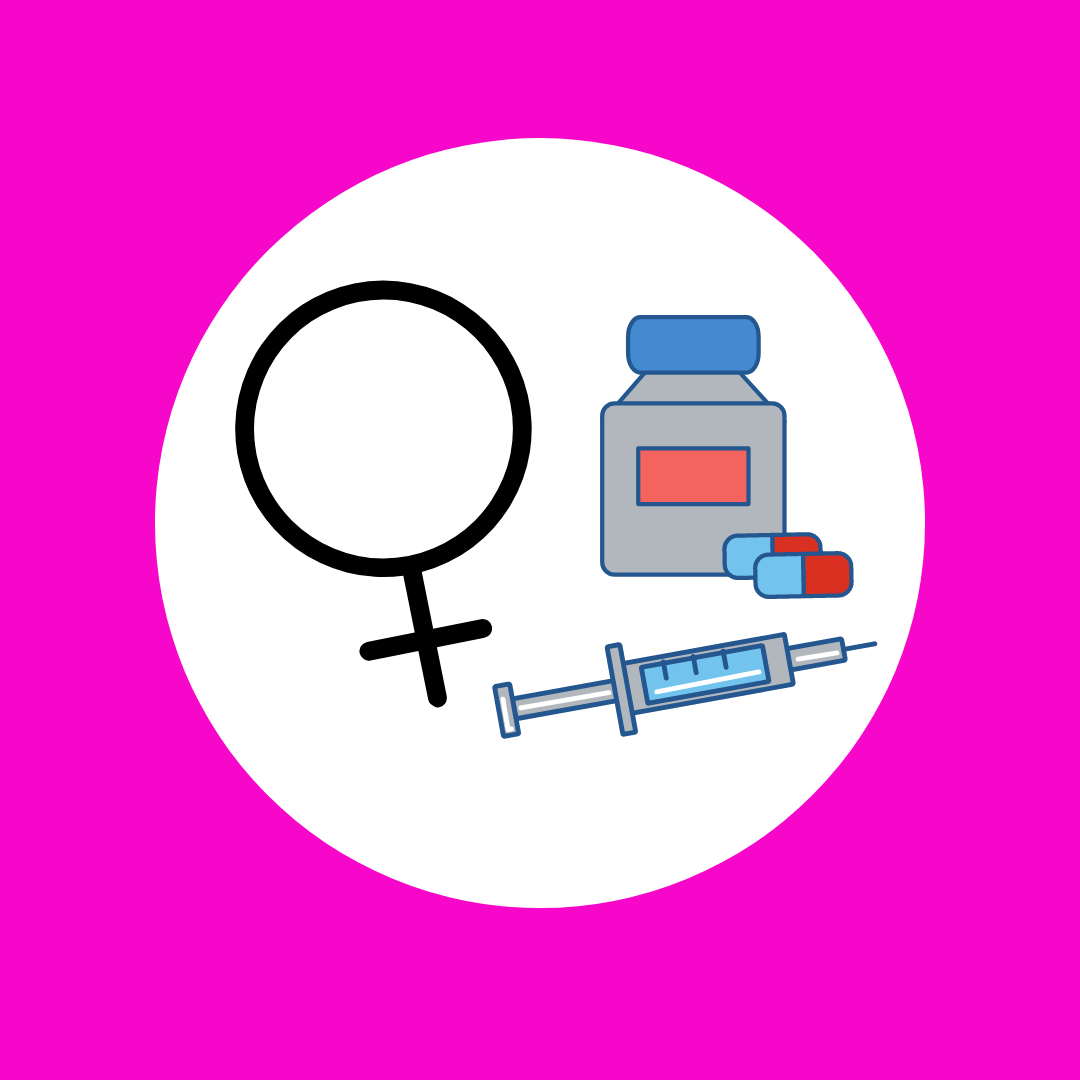Not all trans women experience gender dysphoria. But for those who do, that disconnect between one’s assign sex at birth and one’s gender identity can be distressing, leading to depression, anxiety, and poor self-esteem.
One way to alleviate that distress is to undergo hormone therapy (HRT), which involves the use of MTF hormones like estrogen and progesterone to encourage physical changes in one’s body. These changes will have a “feminizing” effect on the body, bringing patients one step closer to feeling happier and more comfortable in their own skin.
There is no one-size-fits-all solution to gender dysphoria. But if you think that hormones could help you, read on to discover how hormone therapy works, what MTF HRT body changes look and feel like, and how you can prepare for the process.
The Basics Of Hormone Therapy
Gender affirmation is a process that transgender and non-binary individuals can take to affirm their gender identity and live authentically in that identity. There are several dimensions of gender affirmation, including social, psychological, legal, and medical gender affirmation.
Hormone therapy is a subset of gender-affirming health care, along with things like puberty blockers, speech therapy, mental health counseling, and gender confirmation surgery.
As mentioned, not all transgender people need or want hormone therapy. However, for those who don’t feel at ease or at home in their bodies, hormones can help lessen or even eliminate that dysphoria. For trans girls undergoing HRT, MTF (male-to-female) hormones like estrogen, progestin, and androgen blockers can reduce their “masculine” characteristics and bring about more “feminine” features. Not only can this alleviate the symptoms of dysphoria, it can also reduce psychological distress, boost one’s self-image and self-worth, and improve one’s sex life.
Hormones For Male To Female Transition: How Do They Work?
Everyone has hormones. These “chemical messengers” send signals to different parts of the body, stimulating growth, digestion, fat burning, sex drive, and reproduction.
There are three kinds of sex hormones – androgens, estrogen, and progesterone – which all help develop and stimulate our reproductive organs, along with our secondary sex characteristics, like our body/facial hair, bone growth, etc.
People born with ovaries typically have more estrogen and progesterone in their bodies, so they’re more likely to develop breasts and grow less hair. On the flipside, people born with testicles typically have more androgens like testosterone and DHT, which contributes to body and facial hair growth, increase of muscle mass, voice deepening and other typically “masculine” traits.
When a person is transitioning from male to female, or undergoing feminizing hormone therapy, they are placed on a program that involves androgen blockers and estrogen hormones. In some cases, progesterone is prescribed as well.
Androgen Blockers
Androgen blockers, also known as antiandrogens or T-blockers, quite literally block one’s testosterone receptors, reducing the masculinizing effects of testosterone. It is important to note that T-blockers don’t impact testosterone production on their own, which is why antiandrogens usually go hand-in-hand with estrogen.
Antiandrogens can also minimize some of the health risks associated with estrogen. Taking too much estrogen can be harmful, so antiandrogens help to reduce one’s “masculine” characteristics and allow them to take estrogen in smaller, safer doses.
The most commonly prescribed androgen blocker is spironolactone, or “spiro”. For most patients, spiro is taken twice a day for several weeks before they start their estrogen program. Spironolactone can have adverse effects, such as excessive urination and lightheadedness. If a patient experiences these or other undesirable symptoms, they can be put on gonadotropin-releasing hormones (GnRH) instead. These tell the pituitary gland to stop sending testosterone-producing signals to the testicles. One major downside to GnRH agonists, however, is cost.
Because of these factors, not everyone can or wants to take androgen blockers – but that decision is left to the individual, along with the advice of a healthcare professional.
Estrogen
Estrogen is the primary hormone responsible for “feminine” traits. In people born with ovaries, estrogen helps stimulate ovulation, maintains the thickness of the vaginal wall, and urges breast development. Estrogen also plays a role in protecting our bones and skin from injury. There are three types of estrogen – estradiol, estriol, and estrone.
For transgender women, estradiol helps with breast growth, body fat redistribution, and thinning body and facial hair. However, estrogen can also affect things like one's libido and the size of one’s genitals, as well as lead to lower testosterone levels.
Estrogen can be taken as a pill, an injection, a gel, spray, or patch. Depending on your treatment plan, you may be able to take estrogen after four to eight weeks on spiro.
Progesterone
Progesterone is a hormone that helps regulate the menstrual cycle and maintain pregnancy in cisgender women. With regards to hormone therapy in transgender women, progesterone is believed to aid in breast tissue growth, body fat redistribution, and mood and libido enhancement. However, there isn’t a lot of scientific evidence to back this up yet.
Depending on the user and the dosage, progesterone may also cause anxiety, depression, and irritability, as well as weight gain and high blood cholesterol. This is why progesterone isn’t very common yet as a hormone treatment.
GAHT vs Hormone Replacement Therapy
For the longest time, hormone therapy was referred to as Hormone Replacement Therapy or HRT. However, it is important to note that, in medical communities, Hormone Replacement Therapy is also used to describe the process of relieving symptoms of hormone imbalance in cisgender people. For example, menopausal women use estradiol valerate to manage symptoms like hot flashes and vaginal discharge.
These days, medical professionals prefer the term gender-affirming hormone therapy (GAHT) as it is more specific and targeted towards trans and non-binary individuals.
The Effects Of Feminizing Hormones On The Body
Hormone therapy produces a range of changes in the body, from physical and emotional to sexual and reproductive changes. Here are some of the effects you are likely to experience should you begin a feminizing hormone treatment plan:
MTF HRT Timeline Of Physical Changes
Whether you’re not ready to start making major changes to your body yet or you’re simply more comfortable in an androgynous appearance, you can start with T-blockers like spiro first. One of the advantages of taking spiro is that the effects are mostly reversible. So if you’re not happy with the way your body is changing, you can get off spiro and go back to how your body was prior to taking it.
Within the first three months on spiro, you can experience the following changes:
- Decreased libido
- Fewer spontaneous erections
- Decrease in ejaculatory fluid
Within two years of taking spiro, you can expect:
- Slower male pattern baldness and reduced scalp hair loss
- Decrease in facial and body hair growth
- Minimal breast tissue growth
When you start taking estrogen, your body will take on a more “feminine” appearance. In the first six months of estrogen treatment, you can experience:
- Smoother skin
- Changes in muscle tone and decrease in muscle mass
- Body fat redistribution to hips and breasts
- Decrease in sex drive
- Decrease in spontaneous erections
- Decrease in ejaculatory fluid
Within two to three years, you will experience gradual changes in the following areas:
- Breast development and nipple growth. You may experience discomfort and pain in the first few months of this process. Do note that breasts only typically grow up to a cup A or B in trans women. However, if you are interested in breast augmentation, remember that breast growth can take two or more years to finish.
- Slowing down or stopping of balding
- Reduction in size of testicles
Emotional Changes
Think of hormone therapy as a second puberty. As your body changes every day, you will experience a range of emotional and psychological changes, from mood swings to changes in your sexual interests.
This experience may feel overwhelming and confusing at some points, so it’s important that you have a solid support system, whether it be a group of friends you can trust, a supportive family, or a therapist. Make sure to surround yourself with people who can give you love, support, and encouragement through the rough spots.
Sexual Changes
As mentioned earlier, estrogen and antiandrogens can have an impact on your sex drive. As you continue your hormone treatment, you will notice a decrease in your ability to have and maintain erections. However, you will still be able to orgasm and feel sensations.
You can also expect your testicles to reduce to about half their normal size.
Reproductive Changes
If you’re interested in having biological children in the future, you will need to consult with your physician about your options. This is because hormone therapy can affect your ability to create sperm. While there is a chance for sperm count to return, there is also a chance that you may lose the ability permanently. As a precaution, you could consider preserving your sperm before you start treatment.
Note that HRT affects everyone differently. While it does lower sperm count in a lot of people, it doesn’t necessarily mean that you won’t be able to get anyone pregnant. If you're sexually active with someone who can get pregnant and want to avoid unwanted pregnancies, make sure to use birth control.
Frequently Asked Questions
Here are some of the most commonly asked questions about feminizing hormone therapy:
Are these changes permanent?
In most cases, breast growth, fat distribution to the hips, and changes in fertility are permanent. Everything else, from skin smoothness to muscle mass changes, may be reversible to some degree if you stop taking your medicine.
What doesn’t change?
Some parts of your body won't be affected by hormone therapy, including your bone structure, Adam's apple, height, and voice. There are, however, cosmetic procedures that can help make the Adam's apple less visible. Transgender women can also elect to undergo voice training to change the tone and the pitch of their voice.
Hormone therapy also does not completely eliminate body hair. If you still feel like you are hairier than you had hoped to be, you can opt for laser hair removal or electrolysis. Do note that many cisgender women have noticeable body hair as well.
Are there risks involved?
Estrogen can have a negative effect on your body, especially if you don't undergo a physical and psychological assessment prior to starting your treatment.
Feminizing hormone therapy is not recommended for people who have (or have a family history of) the following:
- Deep vein thrombosis, pulmonary embolism, or other thromboembolic diseases
- Prostate cancer or other hormone-sensitive cancers
- An undiagnosed or uncontrolled mental illness
- High levels of potassium and/or high blood pressure
- Cardiovascular disease
- Estrogen can also cause significant weight gain, so if you are prone to diabetes, heart disease, and obesity, bring this up with your doctor. Finally, take note that high amounts of estrogen can increase your risk of breast cancer.
How do I prepare for hormone therapy?
Because of the risks involved, it is important that you get in touch with a doctor who specializes transgender patient care. Everyone has different sex hormone levels, so each treatment plan will be tailor-fit to you and your needs.
Before you are placed on any medications, you will be asked to undergo a medical evaluation, which includes:
- A review of your medical history
- A physical exam
- Lab tests, including those that measure your blood sugar, blood count, liver enzymes, electrolytes, lipids, and prolactin
- A review of your past and current use of tobacco, drugs, and alcohol
- Identification of any sexually transmitted infections and/or HIV
- A list of any surgeries and procedures you have undergone, as well as any medicine you're currently on
- Discussions about future surgeries, including gender affirmation surgery, breast augmentation, laser hair removal, electrolysis hair removal, etc.
- A psychological evaluation, which involves discussions about your relationship with your gender identity and dysphoria; your relationships at home, work, school, and your community; and any instances of self-harm.
Adolescents seeking care who are under the age of 18 will have to be accompanied by a parent or guardian. You will also be advised to see a behavioural therapist to talk about your expectations and to assess whether you are ready for such a big change.
Final Thoughts
Hormone therapy isn’t for everyone – it is, after all, just one dimension of transitioning and gender affirmation. Other steps include social affirmation, such as coming out to close friends and family, as well as legal affirmation, which involves changing one’s name and gender markers on important documents.




Leave a comment
This site is protected by hCaptcha and the hCaptcha Privacy Policy and Terms of Service apply.